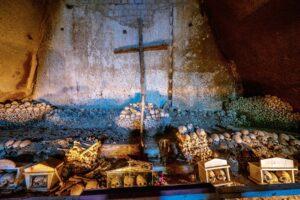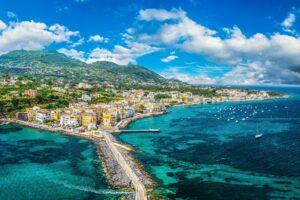Fodor's Expert Review Duomo di Napoli
Hemmed in on three sides, this cathedral is a trip through the city's history. Although the cathedral was established in the 1200s, the building you see was erected a century later and has since undergone radical changes—especially during the Baroque period. Inside, ancient columns salvaged from pagan buildings rise to the 350-year-old richly decorated false wooden ceiling (the original Gothic ceiling is 6 meters higher). Off the left aisle, step down into the 4th-century church of Santa Restituta, which was incorporated into the cathedral. Though Santa Restituta was redecorated in the late 1600s in the prevalent Baroque style, the Battistero (Baptistery) is the oldest in the Western world, with what some claim to be the most beautiful mosaics in Italy.
On the right aisle of the cathedral, in the Cappella del Tesoro di San Gennaro, multicolor marbles and frescoes honor St. Januarius, the miracle-working patron saint of Naples, whose altar and relics are encased in silver. Three... READ MORE
Hemmed in on three sides, this cathedral is a trip through the city's history. Although the cathedral was established in the 1200s, the building you see was erected a century later and has since undergone radical changes—especially during the Baroque period. Inside, ancient columns salvaged from pagan buildings rise to the 350-year-old richly decorated false wooden ceiling (the original Gothic ceiling is 6 meters higher). Off the left aisle, step down into the 4th-century church of Santa Restituta, which was incorporated into the cathedral. Though Santa Restituta was redecorated in the late 1600s in the prevalent Baroque style, the Battistero (Baptistery) is the oldest in the Western world, with what some claim to be the most beautiful mosaics in Italy.
On the right aisle of the cathedral, in the Cappella del Tesoro di San Gennaro, multicolor marbles and frescoes honor St. Januarius, the miracle-working patron saint of Naples, whose altar and relics are encased in silver. Three times a year—on September 19 (his feast day); on the Saturday preceding the first Sunday in May, which commemorates the transfer of his relics to Naples; and on December 16—his dried blood, contained in two sealed vials, is believed to liquefy during rites in his honor; the rare occasions on which it does not liquefy portend ill, as in 1980, the year of the Irpinia earthquake. The most spectacular painting on display is Ribera's San Gennaro in the Furnace (1647), depicting the saint emerging unscathed from the furnace while his persecutors scatter in disarray. These days large numbers of devout Neapolitans offer up prayers in his memory. The Museo del Tesoro di San Gennaro houses a rich collection of treasures associated with the saint. Paintings by Solimena and Luca Giordano hang alongside statues, busts, candelabras, and tabernacles in gold, silver, and marble by Cosimo Fanzago and other 18th-century Baroque masters.
READ LESS







